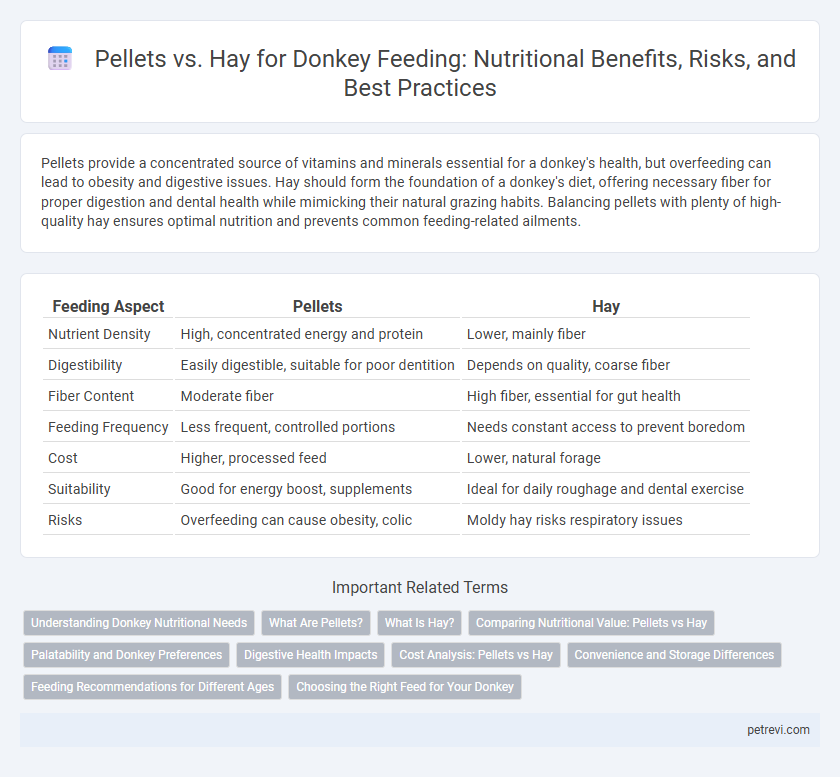Pellets provide a concentrated source of vitamins and minerals essential for a donkey's health, but overfeeding can lead to obesity and digestive issues. Hay should form the foundation of a donkey's diet, offering necessary fiber for proper digestion and dental health while mimicking their natural grazing habits. Balancing pellets with plenty of high-quality hay ensures optimal nutrition and prevents common feeding-related ailments.
Table of Comparison
| Feeding Aspect | Pellets | Hay |
|---|---|---|
| Nutrient Density | High, concentrated energy and protein | Lower, mainly fiber |
| Digestibility | Easily digestible, suitable for poor dentition | Depends on quality, coarse fiber |
| Fiber Content | Moderate fiber | High fiber, essential for gut health |
| Feeding Frequency | Less frequent, controlled portions | Needs constant access to prevent boredom |
| Cost | Higher, processed feed | Lower, natural forage |
| Suitability | Good for energy boost, supplements | Ideal for daily roughage and dental exercise |
| Risks | Overfeeding can cause obesity, colic | Moldy hay risks respiratory issues |
Understanding Donkey Nutritional Needs
Donkeys require a diet high in fiber and low in sugar and starch to maintain optimal health, making hay an essential component for meeting their roughage needs. Pellets, often more calorie-dense and nutrient-concentrated, can lead to weight gain and digestive issues when overfed, especially if they contain high amounts of molasses or grains. Understanding the balance between providing adequate fiber through hay and carefully regulated pellet supplementation helps prevent obesity, laminitis, and other metabolic disorders common in donkeys.
What Are Pellets?
Pellets are concentrated feed blocks made from compressed alfalfa, grains, and vitamins designed to provide balanced nutrition for donkeys in a controlled portion size. They offer a higher energy density compared to hay, making them suitable for donkeys with increased dietary needs or those requiring supplementation. Proper portioning of pellets is essential to prevent overfeeding and maintain optimal digestive health in donkeys.
What Is Hay?
Hay is dried grass or legumes, such as alfalfa or timothy, harvested and stored as a primary forage source for donkeys. Rich in fiber, hay supports healthy digestion and mimics the natural grazing diet of donkeys, promoting dental health and preventing colic. Unlike pellets, hay provides bulk and encourages natural chewing behavior essential for maintaining proper gut motility in donkeys.
Comparing Nutritional Value: Pellets vs Hay
Pellets offer a concentrated source of nutrients with consistent protein, fiber, and vitamin content, making them an efficient choice for balancing a donkey's diet. Hay provides essential roughage and promotes natural chewing behavior but varies in nutritional value depending on its type and quality, such as Timothy or alfalfa hay. Combining pellets and hay ensures adequate fiber intake while meeting energy and nutrient requirements critical for a donkey's digestive health and overall well-being.
Palatability and Donkey Preferences
Donkeys show a strong preference for hay over pellets due to its natural texture and taste, which aligns closely with their evolutionary diet of fibrous plants. Hay provides essential roughage that supports proper digestion and dental health, whereas pellets, despite being nutrient-dense, may be less palatable to donkeys, leading to reduced intake or selective feeding. Offering a diet that prioritizes high-quality hay ensures optimal palatability and encourages consistent consumption, promoting overall donkey well-being.
Digestive Health Impacts
Pellets provide a controlled source of nutrients but may lack the high fiber content essential for a donkey's digestive health, which hay naturally offers. Hay supports the donkey's hindgut fermentation by promoting continuous chewing and saliva production, crucial for preventing colic and digestive upset. Feeding a diet primarily based on hay helps maintain gut motility and microbial balance, reducing the risk of digestive disorders compared to pellet-heavy diets.
Cost Analysis: Pellets vs Hay
Pellets typically offer a more concentrated source of nutrients but come at a higher cost per kilogram compared to hay, making hay a more economical choice for bulk feeding donkeys. Hay prices fluctuate based on quality and availability, often rendering it a cost-effective option for maintaining donkey health over time. Evaluating cost per nutrient unit reveals that while pellets may reduce feeding volume, hay remains the preferred option for minimizing overall expenses in donkey care.
Convenience and Storage Differences
Pellets offer a compact and easy-to-store option for donkey feeding, requiring less space and reducing spoilage risk compared to bulky hay. Hay demands larger storage areas to maintain freshness and prevent mold growth, often needing covered, well-ventilated environments. Choosing pellets improves feeding convenience with measured portions and minimal preparation, while hay necessitates regular handling and monitoring.
Feeding Recommendations for Different Ages
Donkey feeding recommendations vary by age, with young donkeys requiring nutrient-dense pellets to support growth and development, while adult donkeys thrive on high-fiber, low-calorie hay to maintain optimal weight and digestive health. Pellets provide essential vitamins and minerals for growing donkeys but can lead to obesity in mature donkeys if overfed. Senior donkeys benefit from a mix of softer hay and limited pellets, ensuring easy digestion and balanced nutrition.
Choosing the Right Feed for Your Donkey
Choosing the right feed for your donkey involves understanding the nutritional benefits of pellets versus hay. Hay provides essential fiber that supports healthy digestion and mimics natural grazing, while pellets offer concentrated nutrients and vitamins tailored to your donkey's specific dietary needs. Prioritize high-quality, low-sugar pellets and forage to maintain optimal weight and prevent laminitis in donkeys.
Pellets vs Hay for Donkey Feeding Infographic

 petrevi.com
petrevi.com